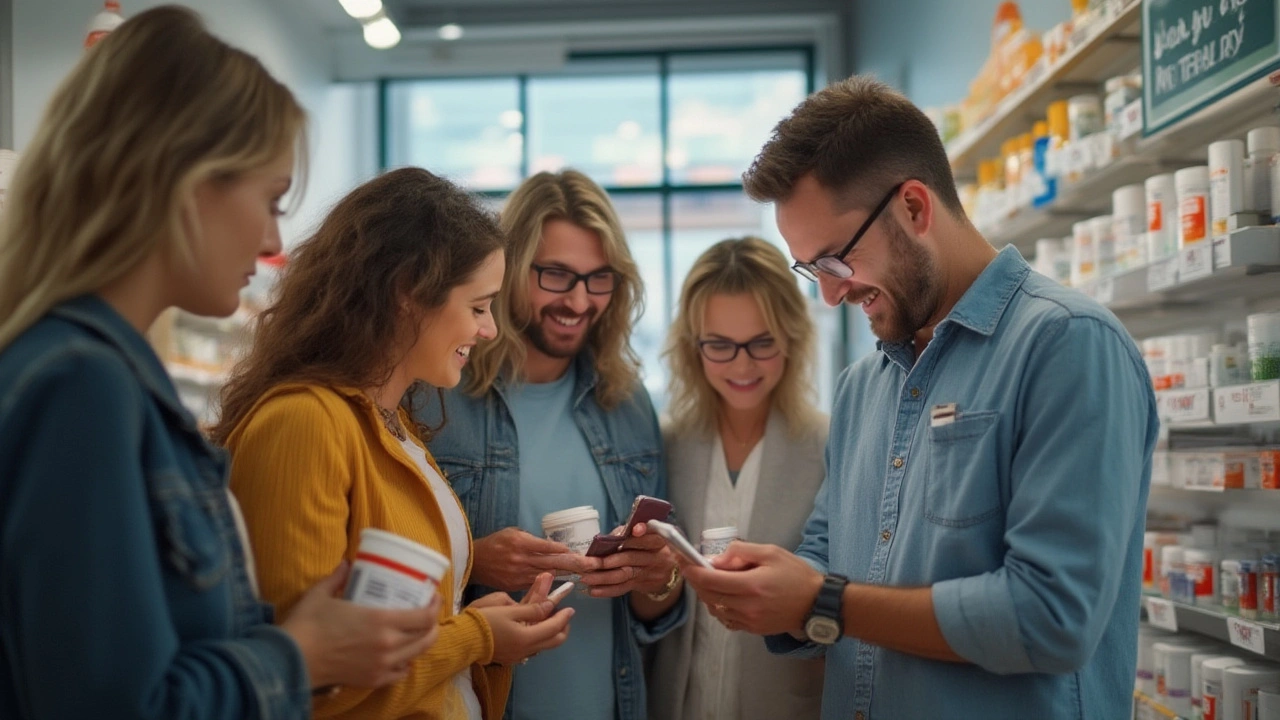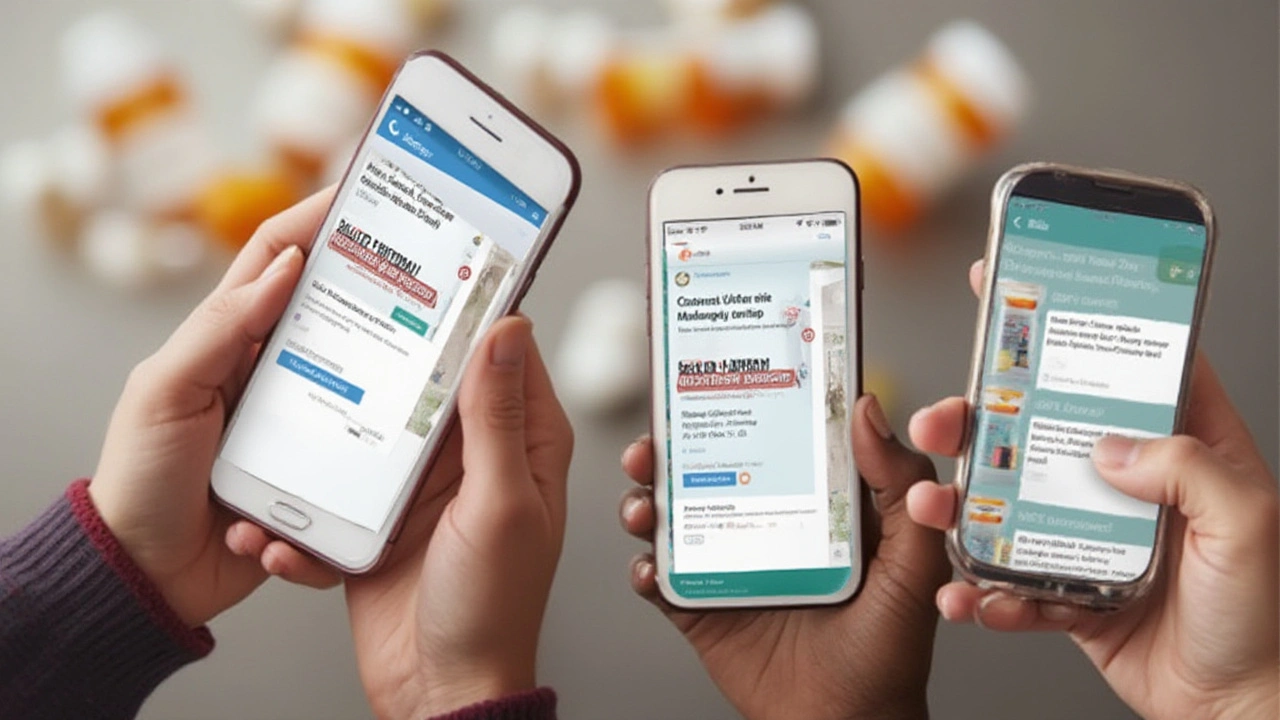Choosing the Best Prescription Coupon Platform: Fees, Usability & Acceptance Compared
 Jul, 11 2025
Jul, 11 2025
How much did you pay for your last prescription? Did you ever get that sinking feeling—you know, the one when you swipe your card and see way more dollars vanish than you expected? This is the pharmacy checkout lottery, and honestly, it shouldn't feel like gambling when you're just trying to stay healthy. The prices for one medication can swing by $100 or more just based on which card, coupon, or platform you use. So, here’s the real question: which prescription coupon platform will actually save you money with as little effort and confusion as possible?
The market is suddenly full of players promising discounts, but not all are created equal. Some have hidden fees. Some are accepted almost everywhere, others barely at any pharmacy in your area. Some websites make it so easy, my kid Sorrel could navigate them, while others are like solving those puzzles you find in escape rooms. It's easy to feel overwhelmed, frustrated, or even skeptical. But ignore the noise—because there is an approach that works, no spreadsheets or headaches required.
Understanding Platform Fees and Hidden Costs
Let’s face it, just because something is labeled as “free” doesn’t mean it won’t cost you in the long run. Some prescription coupon platforms actually hide their fees in the fine print or add them onto the cost at the pharmacy register. Others get you with annual memberships. You need to know what you’re up against before signing up or using a coupon. Let’s break down the main types of fees you might encounter:
- Per-transaction fees: A few platforms tack on a processing fee every time you use a coupon. You only see it on your receipt—frustratingly sneaky.
- Membership or subscription costs: While some are free for basic access, VIP programs charge a monthly or yearly fee for “premium” offers. These can add up fast, so calculate whether the extra savings are worth the membership.
- Markup on medication: Some services negotiate a price with pharmacies, but actually inflate it above what you’d pay using a competitor’s coupon—hoping you won’t notice the difference.
- Hidden data costs: Using a coupon often means giving up your privacy. Some platforms sell your data to advertisers or pharmaceutical companies, so factor that into your definition of “cost.”
For reference, a 2024 consumer report found that only three of the ten most popular coupon programs had zero hidden transaction costs—two were free, and one had an optional paid premium tier but clearly disclosed it. Always read the FAQ and “terms” pages carefully. Look for platform reviews that mention actual, out-the-door prices from people in real-world situations, not just sponsored influencers.
To boil it down, here’s what you should look for in the fee structure:
- Are all fees mentioned up front? If you have to dig around for pricing, consider it a red flag.
- Does the platform try to get you to upgrade after you sign up, claiming you’ll miss out unless you pay?
- Is there a price match or refund policy if the coupon doesn’t get you the expected rate at checkout?
Transparency isn’t just a buzzword here—it literally saves you dollars, probably every month if you fill several prescriptions for your family. Next time you try a new coupon app or website, ask yourself: who’s really paying for these advertised “savings”?

Weighing Usability and Everyday Experience
Fees matter, sure, but how easy is it to use the platform—in real life, not just in screenshots? I’ve stood at the pharmacy with a cranky toddler and a line of impatient strangers behind me, jabbing at a slow-loading app, just praying the coupon would actually scan. That’s when you realize: usability isn’t optional. It’s everything.
Here’s the stuff that truly separates the winners from the clunky contenders:
- App or website interface: Forget slick advertising. Can you actually enter your medication, dosage, and zip code in under a minute? If the site crashes, or if you need a computer science degree just to search for your prescription, it’s not worth your time.
- Account signup friction: Do they bombard you for email, phone number, or extra forms before showing prices? Some let you browse and compare anonymously. Others require an account or even health insurance info—unnecessary for straightforward price comparisons.
- Coupon retrieval: Can you access, screenshot, or print your coupon in the middle of a busy pharmacy? Or do you have to log in, wait for a code to your email, then re-log in? It sounds silly, but in a time crunch, you want to be able to say, “Here, scan this,” and be on your way.
- Customer support: If the code isn’t accepted at checkout, are you stuck? Look for platforms that offer chat, phone, or fast email support—not just FAQ pages buried six clicks deep.
There’s this underrated factor, too: local pharmacy compatibility. Many of the so-called top apps list prices for major national chains, but what if you use a local or independent pharmacy? Some platforms do a terrible job of showing which locations will take their coupons. On the flip side, I’ve seen a few that let you filter by pharmacy type or distance, so you don’t end up driving across town for a $3 discount at some out-of-the-way chain.
Let’s get even more concrete. The best platforms typically offer:
- Fast price-checking with no account required
- A QR code or simple barcode option to show to your pharmacist
- Instant updates when pharmacy prices or coupon terms change
And don’t ignore accessibility for people with visual or physical disabilities. Some websites are notoriously bad at this.
It’s easy to get swayed by brand names or big advertising campaigns, but the best indicator of a slick, stress-free experience is real-world feedback. Look for platforms with plenty of mentions of customer experiences specifically at the pharmacies you use—and don’t just count on reviews from tech pros who’ve never set foot in a CVS or Walgreens.
Want the best shot at a hassle-free pharmacy trip? Use comparison posts like this list of alternatives to GoodRx — you’ll spot how different platforms measure up with things like navigation, support, and how smoothly you can actually get your discount applied.

Comparing Acceptance Rates: Where More Really is Better
None of that matters if the pharmacist just shrugs and hands your coupon back. Acceptance rates—the percentage of pharmacies that actually honor a given coupon or savings card—should be front and center in your decision. Some companies have direct contracts with the big national chains, so you’ll almost always save at CVS, Walgreens, or Walmart. But what about regional chains, specialty pharmacies, or small town independents? The answer is all over the map (sometimes literally).
The biggest prescription coupon programs typically quote acceptance rates of 70-95% across the United States. Sounds impressive, but there are big asterisks:
- Acceptance is usually much lower at small independent pharmacies, and rural areas often have far fewer options. Your coupon might be rejected even if the website said otherwise.
- Specific medications gotchas: Some drugs—especially generics or specialty meds—may not be discounted as much, or at all, through certain platforms. Always search for your actual prescription, not just the brand name.
- Expired offers: Coupon codes or digital cards that look valid on the site may already be discontinued at your pharmacy, or your pharmacist might not have seen it before and be unsure how to apply it.
It’s not about finding the platform that lists a billion pharmacies—it’s about the percentage where those discounts actually work, instantly, and without you making six phone calls.
Here’s a quick look at typical acceptance rates by chain type, based on 2025 data:
| Pharmacy Type | Avg. Acceptance Rate |
|---|---|
| National Chain (CVS, Walgreens, Walmart, Rite Aid) | 89% |
| Regional Chain (HEB, Publix, Meijer, etc.) | 73% |
| Independent/Locally Owned | 51% |
| Specialty/Compounding | 38% |
The key? Search for your specific pharmacy and medication combination. Many platforms now include real-time acceptance badges, but real-world trial-and-error from user reviews is still the gold standard. If you regularly fill at somewhere like Costco, be aware some platforms are accepted and others flatly aren’t—find out before you snag the coupon, not when you're holding an unredeemable barcode.
For families who travel or manage multiple prescriptions (hello, me and every other mom on earth), a wide network really matters. But so does reliability. Apps that partner more closely with pharmacy networks tend to have higher acceptance rates overall, but sometimes at the cost of slightly smaller average discounts. On the other hand, those with wild savings claims often leave you with a fat “Sorry, not honored here.”
Want a tip that’s saved me cold hard cash? Before you head to the pharmacy, call ahead and ask: “Do you accept coupons from X platform for [medication name]?” It takes 30 seconds and has prevented more than one meltdowns-with-kids-in-tow.
The bottom line is identifying a prescription coupon platform that matches how (and where) you fill your medications, takes only a minute or two per month to use, and is totally upfront about fees, usability quirks, and which pharmacies actually say yes. Don’t settle for the first coupon you find in a search—stack the odds in your favor using reviews, comparison tables, and a clear-eyed look at where your money really goes.

Nicole Carpentier
July 17, 2025 AT 05:46I used to stress over every prescription until I found GoodRx + my local pharmacy’s loyalty program. Now I just check both before I leave the house. No apps, no logins, no drama. Saved me $80 on my thyroid med last month. Seriously, try it. It’s that simple.
Also, call the pharmacy. Always. 30 seconds saves hours of crying in the parking lot.
Stop overcomplicating it.
Love you all. Stay healthy.
Hadrian D'Souza
July 18, 2025 AT 18:54Oh wow. Another feel-good guide for people who think ‘research’ means reading a headline and then clicking ‘apply’. You literally wrote 1,200 words to say ‘check prices and call ahead’.
Meanwhile, I’m over here using SingleCare and paying $3.27 for my blood pressure med because I didn’t fall for the ‘free coupon’ bait-and-switch. The rest of you are still arguing over whether Walgreens accepts QR codes like it’s 2012.
Let me guess-you also think ‘organic’ means ‘expensive’ and ‘VPN’ is a type of yoga.
Pathetic. Just pay cash. No platform needed. You’re being milked by middlemen who don’t even know what a pill looks like.
Brandon Benzi
July 20, 2025 AT 11:11These coupon apps are just socialist propaganda disguised as savings. Real Americans don’t need some Silicon Valley app to tell them how to buy medicine. We used to walk into the pharmacy, hand over cash, and get our pills. No tracking. No data harvesting. No ‘premium tier’. Now we’re supposed to sign up for five different services just to get a $15 discount on metformin?
It’s not about saving money-it’s about control. And they want you dependent on their apps. Don’t be fooled. The real discount? Walking out without your phone.
Buy generic. Pay cash. Keep your privacy. That’s the American way.
Abhay Chitnis
July 22, 2025 AT 05:10Bro, GoodRx is garbage in India. I tried it last month for my dad’s diabetes meds. Zero acceptance. Zero. Then I found Practo Pharmacy-$12 for 30 days supply. No app. No login. Just WhatsApp. Send pic of script, get price. Done.
USA you guys are so lost. Why do you need 17 apps for one pill? 😂
Also, data selling? Bro, I sold my data to a startup for free chai. They sent me 3 coupons. I used one. Saved $5. Win win. 🤝
Robert Spiece
July 23, 2025 AT 13:06There’s a deeper question here, and you all are missing it. Why does medicine have to be a market transaction at all? Why are we treating healthcare like a game of coupon roulette? We’ve normalized the absurdity-paying for survival like it’s a discount at a thrift store.
Some of you are proud of saving $20 on insulin. That’s not a win. That’s a failure of society.
Meanwhile, the real cost isn’t the coupon-it’s the moral bankruptcy of a system that lets a child’s asthma inhaler cost more than a new pair of sneakers.
Don’t optimize the broken system. Burn it down and rebuild it. Or keep scrolling. Your phone’s watching.
Either way, you’re complicit.
Vivian Quinones
July 24, 2025 AT 13:04Just use GoodRx. That’s it. End of story. Everything else is fake. The government doesn’t want you to know this but it’s true. I’ve been doing it for 7 years. No drama. No stress. Just swipe and save. America’s best kept secret. Don’t listen to the haters. They’re just mad they don’t know how to use an app.
Also, Walmart. Always Walmart. And cash. Cash is king. 💪🇺🇸